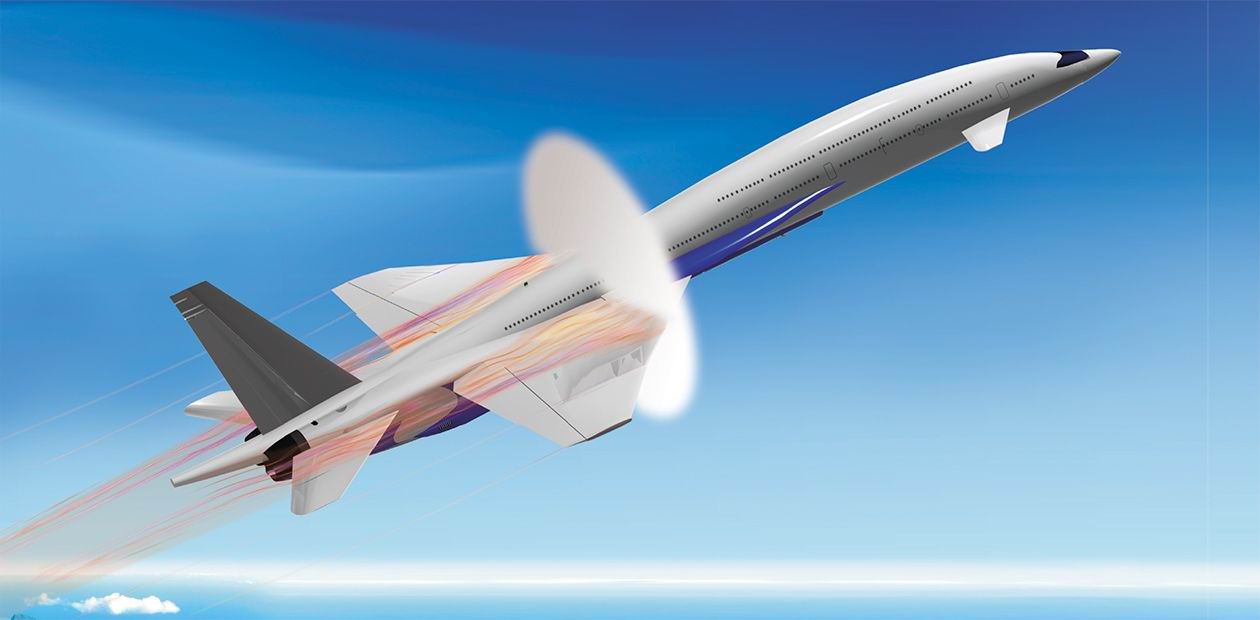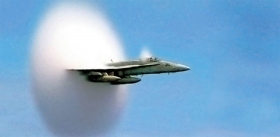With a Velocity of Sound: Conquering Transonics
Long-range passenger airplanes do not fly with a supersonic velocity today. “Supersonic” projects TU-144 and Concorde turned out to be cost-inefficient. The first attempt to break the sonic barrier for peaceful purposes failed, because when an airplane approaches the sonic barrier, the drag drastically increases, while the lift force decreases. If we don’t have “supersonics”, what is it that we have? It’s “transonics”.
Transonic velocities cover the range slightly higher and slightly lower than the velocity of sound (approximately from 0.8 to 1.2 of the velocity of sound). The term had to be introduced to describe the transitional flow regime, with part of the flow becoming supersonic and the other part of the flow remaining in the subsonic regime
In the high and far-off times
Investigations aimed at increasing the flight velocity and lift-to-drag ratio of airplanes were started back in the 1930s. At the turn of the 1930s—1940s, it was experimentally proved that the drag of wings and other airplane elements drastically increases with increasing flight velocity. Moreover, the behavior of the lift force and the pitching moment also becomes unpredictable. The reason for these phenomena was found to be the emergence of flow regions where the velocity of air with respect to the body is greater than the velocity of sound. The airplane velocity at which supersonic flows arise near the airplane surface was called the critical velocity.
Theoretical concepts on the lift and drag forces of the wing at subcritical velocities were shaped under the influence of ideas of N. E. Zhukovskii, an outstanding Russian scientist and the founder of aerodynamics: the wing possesses a lift force because the velocity and, hence, rarefaction (decrease in pressure) near the upper surface is greater than that near the lower surface. The lift force is the difference in pressure at the lower and upper surfaces of the wing. The drag force of infinite-span wings consists of two components: friction drag and frontal drag resulting from incomplete recovery of pressure at the rear part of the wing. These forces are absent in an ideal gas flow around the wings. Finite-span wings also have the so-called inductive drag directly related to the presence of the lift force.
These classical concepts, however, turned out to be insufficient to explain the phenomena observed at flight velocities higher than the critical value. The physical reason for the coincidence of the increase in drag and the emergence of supersonic velocity near the wing surface was not understood either.
By the time the problems arising at critical velocities were recognized, investigations taking into account the effect of compressibility (decrease in gas density with increasing flow velocity) on the pressure distribution over the wing surface were already under way. L. Prandtl, a German physicist, an eminent expert in aerodynamics of that time, suggested that a correction should be introduced to recalculate the pressure and lift force of the airfoil from data for this airfoil in an incompressible gas flow. Experiments showed, however, that Prandtl’s theory was invalid for flow velocities higher than the critical value.
The flow pattern around the wing and the pressure distribution in a subcritical air flow are essentially different from the regime formed at supercritical velocities. There are typical plots of subcritical and supercritical flows. Shock waves arise every time when the particles in a supersonic gas flow hit the body surface or change the direction of their motion by a finite angle within extremely small distances comparable with the mean free path of gas molecules.
The pictures of airplanes overcoming the supersonic barrier clearly display barrel shocks arising in supercritical flight, which depend on the wing shape. When an air molecule enters a narrow layer containing a shock wave, part of kinetic energy transforms to thermal energy as a result of inelastic interaction of molecules with each other. As the kinetic energy of gas decreases behind the shock wave, the total pressure also decreases. In thermodynamics, this process is called irreversible. The entropy S is used as the measure of irreversibility.
The entropy of gas increases in the shock wave. The entropy increment equals the ratio between the amount of kinetic energy transformed to thermal energy owing to inelastic interaction of particles and the absolute temperature of the gas. Since the total energy of the gas remains unchanged and, hence, the total temperature is T0=const, the total pressures behind the shock wave p02 and ahead of the shock wave p01 are related as p02= p01•exp(-∆S/R), where ∆S is the entropy increment in the shock wave and R is the universal gas constant.
Thus, the total pressure of the gas decreases as it passes through the shock wave. This was used further to explain the reason for the increase in the drag of airfoils in a transonic flow. Shock waves are also responsible for the “sonic boom” phenomenon observed in supersonic flight.
TsAGI and problem solution
In 1940, the team headed by Academician S. A. Khristianovich, who worked at that time at TsAGI, the Central Hydroaerodynamics Institute named after Academician N. E. Zhukovskii — the greatest state-supported research center of aircraft in Russia — calculated the drag force induced by the presence of shock waves generated by a supersonic flow transforming to a subsonic flow. This phenomenon was called the wave drag.
It turned out that the shock wave leads to a decrease in pressure in the rear part of the airfoil, which increases the drag force of the body. To validate the theory, it was necessary to perform experiments, for which a wind tunnel with transonic velocities in the test section had to be created.
When working on the wind tunnel, the scientists encountered a considerable physical restriction: in the transonic flow around the airfoil, the shock waves were found to reflect from the test-section walls and to impinge onto the model surface, substantially changing the flow structure. To avoid this problem, S. Khristianovich developed the theory of “short” waves, which allows one to solve problems of interaction of shock waves with various surfaces. Semipermeable surfaces were found to attenuate considerably the intensity of reflected waves. Thus, an idea was put forward to perforate the walls of the test section of the transonic wind tunnel.
The world’s first wind tunnel was created in TsAGI in 1946. Now wind tunnels with perforated walls are an integral part of the equipment of aerodynamic laboratories all over the world. These wind tunnels allow the researchers to obtain aerodynamic characteristics of wing and fuselage models in the transonic range of free-stream Mach numbers,* thus providing a continuous transition through the velocity of sound.
Then, in a short time S. Khristianovich and his team solved the problem of the influence of flow compressibility on the pressure distribution over the wing. The fundamental law of stabilization was established: as the critical velocity is reached, the growth rate of velocity near the airfoil surface becomes less intense than the growth rate of the free-stream velocity. Then the velocity ceases to grow, and the distribution of Mach contours over the airfoil surface, between its leading edge and the shock wave, remains constant and independent of the free-stream velocity. This distribution is called the limiting distribution of Mach numbers, and it is used to calculate the “limiting pressure curve.”
This law is illustrated by the distribution along the airfoil of the ratio of the flow pressure at a point on the airfoil to the pressure at the stagnation point p/p0. This ratio is related to the Mach number by the expression p/p0=(1+M2y-1/2)-y/y-1, where γ is the ratio of the gas specific heats at constant pressure and constant volume. If the Mach number near the surface remains unchanged, the pressure also retains its constant value, which is shown in the plot with the pressure distribution over the upper surface of the airfoil.
The results obtained allowed S. Khristianovich to develop a method to calculate the aerodynamic characteristics of transonic airfoils, based on their characteristics in an incompressible flow. Using this method, one could calculate the limiting pressure curve and then the aerodynamic characteristics at a Mach number equal to unity, with subsequent recalculation to other transonic Mach numbers. (It should be noted that there were no computers at that time, and all calculations were performed with slide rules or adding machines.)
The law of stabilization implies that the rarefaction ceases to increase in the range of supersonic velocities near the airfoil tip, and then the rarefaction decreases with increasing Mach number of the incoming flow or M∞. An increase in the rarefaction on the upper surface of the airfoil occurs for the reason of expansion of the region with supersonic velocities as the shock wave is shifted toward the airfoil tail. At the same time, the rarefaction on the lower surface of the airfoil, where the velocity is still subsonic, continues to increase greatly with increasing M∞.
This leads to deceleration of the growth and then to a decrease in the lift force and pitching moment of the wing, as can be seen from the lift force coefficient plotted as a function of the free-stream Mach number. The drag, vice versa, starts growing because of the decrease in rarefaction in the fore part of the airfoil and the emergence of a rarefaction zone near the airfoil tail.
Understanding of the physical nature of such flow regimes allowed practical design of airfoils and wings with minimized adverse effects. One step in this direction was the use of airfoils with a smaller relative thickness and swept wings with cross sections along which the flow is directed having a smaller thickness than cross sections located perpendicular to their leading edge.
From the mathematical viewpoint, this is as follows: if the free-stream velocity is broken down into components, one parallel to the leading edge of the wing and the other perpendicular to it, the component parallel to the wing span does not affect the pressure distribution over the wing. In this case, the flow around the wing proceeds as if the incoming flow has a velocity lower than the free-stream velocity, which favors the influence of flow compressibility on aerodynamic characteristics. A comprehensive theory of the flow around swept wings was developed by Academician V. V. Struminskii.
Experimental evidence of this theory can be found on the plot of the drag coefficient for swept wings as a function of the Mach number for different sweep angles.
Conquering “transonics”
Later there appeared a possibility of computer modeling of air flows by solving gas-dynamic and boundary-layer equations numerically. This allowed TsAGI to develop the so-called supercritical airfoils, which ensured a higher flight velocity with a prescribed thickness and a prescribed lift force. The basis for creating such airfoils was attenuation of perturbations introduced into the flow by the upper surface of the airfoil, which resulted in an increase in MCR. A small curvature of the upper surface of the supercritical airfoil, however, decreases the fraction of the lift force generated by this surface. To compensate for this phenomenon, the tail part of the lower surface is “clipped off,” which is a typical feature of this class of airfoils.
It is owing to the increase in pressure at the tail part of the airfoil lower surface that the lift force decreasing in the middle part of the upper surface is compensated (the “effect of a flap”). A low level of velocities on the upper surface of supercritical airfoils leads, in a transonic flow, to the formation of a local supersonic zone with smaller acceleration of the flow and with a downstream shift of the barrel shock.
All these factors decrease the shock-wave intensity (the pressure difference on the shock wave) and the wave drag. As a result, a supercritical airfoil may ensure a certain gain in terms of flight velocity: the value of MCR may be increased for a prescribed maximum relative thickness of the airfoil. An important performance property of supercritical airfoils of the second generation is that MCR is independent of the lift force.
The plots with distributions of the pressure coefficient over the upper surface of various airfoils and dependences of the coefficient of their wave drag on the Mach number illustrate the evolution of the distributions of the pressure and wave-drag coefficients in passing from conventional to supercritical airfoils. Another aspect of using supercritical airfoils, which are widely used in the industry producing modern and advanced aircraft, is the possibility of increasing the relative thickness of the airfoil with the value of Mcr being unchanged.
Advanced high-velocity airfoils allow the value of MCR to be increased by 0.05—0.12 or the maximum relative thickness to be increased by 2—5 % of the airfoil chord. The fuel used during the flight is poured into tanks located in the wings; therefore, the wing thickness is an extremely important structural parameter. The use of supercritical airfoils in combination with swept wings can be considered as one of the main today’s directions of improving the aerodynamics of passenger and cargo aircraft.
Several series of airfoils characterized by the maximum critical flight Mach number were designed at TsAGI and the Khristianovich Institute of Theoretical and Applied Mechanics of the Siberian Branch of the Russian Academy of Sciences (ITAM SB RAS). A typical feature of such airfoils is a rather long segment of the airfoil upper surface with a sonic velocity of the flow, i. e., M=1. Hence, the barrel shock can be shifted to the trailing edge of the wing, and the maximum possible decrease in wave drag is reached.
It should be noted that the problems of aerodynamic design call for a comprehensive approach. Thus, flow problems should be solved accurately and rapidly, though the problem of optimization requires repeated solving of these problems for different configurations. Optimization methods should allow obtaining solutions with allowance for aerodynamic and geometric restrictions within a reasonable time. For these reasons, new methods had to be developed.
To meet these requirements, new methods to solve gas-flow equations, to generate the computational grid, and to present the varied boundary geometry; as well as an optimization method, were developed on their basis. A software package was developed at ITAM SB RAS to design optimal airfoils satisfying the above-mentioned aerodynamic and geometric restrictions. By solving the direct optimization problem, which was reduced to the problem of nonlinear programming with arbitrary initial conditions, pioneering configurations of subsonic airfoils designed for the maximum critical Mach number were obtained.
Using these programs, the researchers were able to achieve certain results in the design of airfoils with a considerable relative thickness (18 % and more), which are characterized by the above-noted physical features of the flow. For the currently used airfoils with a relative thickness of 9—12 %, cruising velocities of 900—950 km/h were reached.
On “hot” wings
New principles and advanced technological procedures are currently used for flow control (e. g., energy supply to the flow). According to theoretical investigations performed at ITAM SB RAS, one can halve the wave drag by controlling the flow around conventional (not supercritical) airfoils with the use of pulsed periodic energy supply, which will allow achieving the range of higher flight velocities.
Combining laser and microwave radiation can provide such a supply of energy. Laser radiation initiates minor ionization of the flow, which is sufficient for effective absorption of microwave radiation.
To elucidate the reasons for such a significant decrease in drag, we have to consider both the process dynamics and the steady-state periodic regime of the air flow. The series of plots for the variation of the supersonic zone size and barrel shock intensity in the case of energy supply shows the field of Mach numbers in the flow around a symmetric airfoil.
The last graph shows that the resultant barrel shock is stabilized ahead of the energy-supply zone with insignificant streamwise oscillations caused by a periodic supply of energy. The barrel shock intensity is lower than the shock intensity if the energy is not supplied, because it is formed at lower Mach numbers. For the same reason, the gas passing through the shock wave loses a smaller amount of kinetic energy, thus providing a higher total pressure in the tail part of the airfoil, which involves a decrease in the frontal drag.
Energy supply favors not only the flow reconstruction described above, but also an independent increase in total pressure of the gas p01 owing to an instantaneous increase in temperature in the volume. Our estimates show that the required power of supplied energy is small as compared with the power of the incoming flow. This fact seems to be extremely important, because it guarantees high effectiveness of this method of controlling the flow around the airfoil.
The physical mechanism of decreasing the wave drag of the airfoil owing to energy supply differs from the mechanism of supercritical airfoils. For supercritical airfoils, the decrease in wave drag is achieved by shifting the barrel shock to the tail part of the airfoil. The distribution of the pressure coefficient along the airfoil chord with and without energy supply in different zones of the airfoil demonstrates that much greater values of pressure are obtained in a larger part of the airfoil, beginning from the frontal point of the energy-supply region.
The aerodynamic performance of the object under study is usually estimated by the dependence of the drag coefficient Cx (otherwise, aerodynamic polar) on the lift force coefficient Cy. The aerodynamic polars of the airfoil with asymmetric energy supply at the lower surface only are significantly different from the polars without energy supply for different angles of attack. With such energy supply, the required lift force can be reached owing to lower wave drag, which increases the lift-to-drag ratio of the airfoil.
It is of interest that the drag coefficient becomes stabilized with a monotonic increase in the energy being supplied. The point corresponding to the fore part of the stabilized segment indicates the optimal flight regime from the viewpoint of the maximum range and with allowance for the increase in the lift-to-drag ratio and the decrease in fuel consumption for gas heating.
At this point, the lift force coefficient is smaller than at the maximum lift-to-drag ratio without energy supply. Therefore, the cruising flight with energy supply has to be performed at lower altitudes than the flight without energy supply: this follows from the condition that the aerodynamic lift force should be equal to the airplane weight.
The fact of stabilization of the drag coefficient also allows one to control the lift force with an unchanged value of the wave drag. In the case of supercritical airfoils, it seems reasonable to supply energy to the gas flow only on the lower surface of the airfoil, because the barrel shock on the upper surface is shifted toward the trailing edge of the wing. Using this approach, one can increase the flight range up to 15 %!
Problems associated with overcoming the supersonic barrier for peaceful purposes still remain urgent. An important challenge of today’s civilization is to fly faster and further and to spend less time and money on such flights.
Though transonic velocities have not been “conquered” yet, progress in this direction is obvious, and soon we can expect new approaches to solving the problems formulated long ago by Academician Khristianovich. Passenger aviation is now facing the sonic barrier, and this barrier will certainly be overcome, like many others in the “technological” history of our civilization.
*The dimensionless characteristic of velocity, which is called the Mach number, is the ratio of flight velocity to velocity of propagation of acoustic waves. The Mach number corresponding to the critical flight velocity is called the critical Mach number µk

















